

The 1:1 Classroom: High School Special Education with Tyler. 5 Top Management Tips in the 1:1 Classroom. With 1:1 technology access now the norm, classroom management around devices is another piece of the planning.

We hope these top 5 tips will help you to maximize learning while minimizing distractions in your technology rich, student-centered classroom. Focus on Relationships The beginning of any classroom management plan should start with building positive relationships with students. Experts Weigh in on Key Considerations for K–12 1:1 Programs. Before implementing a one-to-one device program, school districts should have a well-structured integration plan in place, according to experts at the International Society for Technology in Education 2018 conference earlier this year.
This article covers the key things schools need to consider when implementing a one-to-one setup. This includes internet accessibility, teacher preparation, and student preparation. – daughertyc
From training teachers to choosing the right network, bringing personal devices into the classroom is a lot of work.

But, done correctly, there can be many rewards. Schools May Miss Important Internet Questions. How To Implement 1:1 (One-To-One) Technology In The Classroom. In recent years, we've seen an increase in the use of technology in schools.
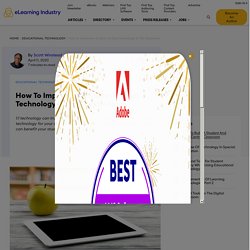
While many schools have seen such an increase, there is still a limited number of schools and districts that have implemented 1:1 technology in classrooms. In the article below, I'll share my thoughts about why providing technology for each student is something more schools should begin implementing. I'll also share some tips and suggestions for getting students, teachers, and classrooms ready for the use of 1:1 technology.
Choosing The Right Technology. Blending High-Effect Instructional Strategies with the 5E Model. Challenging circumstances aside, many educators continue to develop engaging lessons today.
I've never heard of the 5E model before but have long been a fan of inquiry-based instruction. This really helps pull together technology and using the 5E model for your classroom. – daughertyc
But how those lessons get delivered, facilitated, and assessed has changed for some.
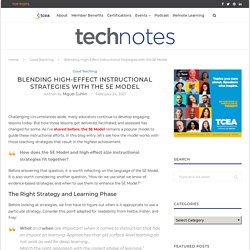
As I’ve shared before, the 5E Model remains a popular model to guide these instructional efforts. In this blog entry, let’s see how the model works with those teaching strategies that result in the highest achievement. How does the 5E Model and high-effect size instructional strategies fit together? The Role of Accessible Technology in Inclusive Education: Maryland Coalition for Inclusive Education. By Kit Mead Introduction Accessible technology can serve an important role in inclusion of students with disabilities.
Accessible materials are no longer optional in our curriculum. Every piece of content should be accessible for all learners and be presented in various ways. This article focuses on innovations in technology that can help make every classroom more inclusive. – daughertyc
Not all technology is accessible, however.

First, we will define accessible technology, and give examples of both accessible technology and inaccessible technology. Then we’ll have a two part section on how it maximizes inclusion, by helping students with disabilities learn and by incorporating the concepts of universal design into learning. What Is Accessible Tech? How to Integrate Technology. Below you will find a quick overview with suggestions of what kinds of tools and activities are best matched with various levels of technology access.
I love this article because it's a good "dip your toes in the water" piece about integrating technology. It is a good starting place to begin thinking about how to integrate technology to make your instruction better. – daughertyc
All of the resources linked to are either free or offer free versions. If your class has an interactive whiteboard and projector: Try interactive websites such as BrainPOP. Dig in to Scholastic's whiteboard activities page. Show online videos related to the lessons. Student Portfolios, Apps and Websites.
This article answers the question of how to develop student portfolios, which are a large part of our CTE program at the high school level. – daughertyc
The Next Tech Thing: Classroom 1:1 Technology Norms: Responsibility, Respect, Focus & Presence. Setting norms is a helpful exercise for a productive meeting.
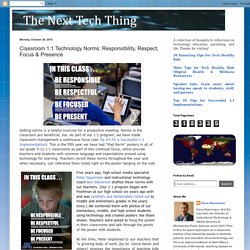
Norms in the classroom are beneficial, too. As part of our 1:1 program, we have made classroom management a continuous focus (see Tip #5 for a Successful 1:1 Implementation). This is the fifth year we have had "iPad Norm" posters in all of our grade 5-12 1:1 classrooms as part of this continual focus, which provide teachers and students with common language and expectations around using technology for learning. Teachers revisit these norms throughout the year and when necessary, can reference them listed right on the poster hanging on the wall. An Alternative to the Lecture: Blended Learning Built on Teacher Expertise. Chaos is one of the most amazing and challenging aspects of the teaching profession.

No matter how hard you plan, your students walk into your classroom every day with different backgrounds, skills, and states of mind, and you have to roll with that. For most educators across the country, nothing is more challenging than effectively differentiating for all learners—it’s a cardinal principle of effective instruction that is extremely difficult to execute well. When we use traditional lectures with a fixed pacing guide, meeting the unique needs of all students can feel like an unconquerable task. Integrating Tech in High School. High school teachers face enormous pressure to prepare students for state standardized tests, college admissions tests, and AP exams.
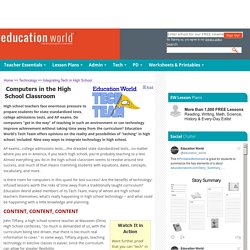
Do computers "get in the way" of teaching in such an environment or can technology improve achievement without taking time away from the curriculum? Education World's Tech Team offers opinions on the reality and possibilities of "teching" in high school. 9 Unique Ways to use Technology in the Classroom.
Finding creative ways to use technology in the classroom can both make your life easier as a teacher and boost student excitement levels and engagement with lessons.
This straightforward article provides nine easy ways to begin implementing technology into your classroom and explains the benefits to students. – daughertyc
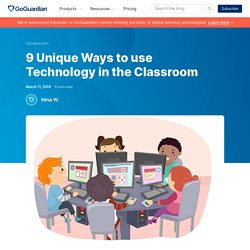
Exploring STEAM Topics with Google Arts & Culture. When it comes to science education, Google Arts & Culture is brimming with possibilities.
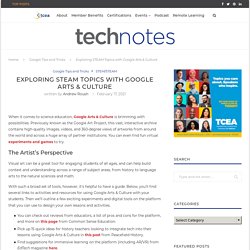
Previously known as the Google Art Project, this vast, interactive archive contains high-quality images, videos, and 360-degree views of artworks from around the world and across a huge array of partner institutions. You can even find fun virtual experiments and games to try. The Artist’s Perspective Visual art can be a great tool for engaging students of all ages, and can help build context and understanding across a range of subject areas, from history to language arts to the natural sciences and math. With such a broad set of tools, however, it’s helpful to have a guide. You can check out reviews from educators, a list of pros and cons for the platform, and more on this page from Common Sense Education.Pick up 15 quick ideas for history teachers looking to integrate tech into their lessons using Google Arts & Culture in this post from Peacefield History. How can I use Edpuzzle with my high school students? – Edpuzzle Help Center. 10 tips to use Google Classroom effectively and efficiently.
Google Classroom streamlines the management of student work — announcing, assigning, collecting, grading, giving feedback and returning. It has certainly saved many teachers hours of work. Without a solid workflow and some strategy, grading digital work can be cumbersome. Photo-Sharing App for Teens Who Love Taking Photos. I don’t know about you, but since Instagram came along, I have gotten a lot better at taking photos, and I bet that’s true of a lot of people in your life.
Before I tell you about a photo-sharing app for teens, let’s start with a quick story. Last June, I went to Amarillo, Texas, to lead workshops for teachers. One of the afternoons, after we finished up for the day, I drove out to Palo Duro Canyon. I was by myself and took a couple of selfies and the picture I included below. There were two girls were standing not too far from me who were also taking pictures.
□ The 101 Hottest EdTech Tools According to Education Experts (Updated For 2020) If you work in education, you’ll know there’s a HUGE array of applications, services, products and tools created to serve a multitude of functions in education. Tools for teaching and learning, parent-teacher communication apps, lesson planning software, home-tutoring websites, revision blogs, SEN education information, professional development qualifications and more.
There are so many companies creating new products for education, though, that it can be difficult to keep up - especially with the massive volumes of planning and marking teachers have to do, never mind finding the time to actually teach! So how do you know which ones are the best? Well, as a team of people passionate about education and learning, we decided to do a bit of research to help you out. We’ve asked some of the best and brightest in education for their opinions on the hottest EdTech of 2020. 27 Tech Tools Teachers Can Use to Inspire Classroom Creativity. Hey there! We use cookies to make sure you have a great experience on our website.
Learn more Got It. Rochelle Township High School Students Use Kami for Studying Novels in English Class. Using Schoology in a High School Setting. 10 fantastic Google tips from the Google Teacher Tribe.
I'm always looking for new Google Tips to share with other teachers. It is such a versatile tool that is constantly evolving. – daughertyc
Tech tip smackdown! 70+ edtech tips from fellow educators. There are some amazing edtech tools out there like Flipgrid, G Suite apps, Kahoot, Gimkit and more.
This article is a nice roundup of edtech tips from educators across the country. – daughertyc
6 Tips for Choosing Educational Technology. Managing Technology: Tips from the Experts.
Technology management is a huge challenge. Not only are you trying to manage the actual devices and keep an accurate inventory, you are also trying to manage what students and teachers are doing on those devices. This article is the first one I've seen that specifically addresses that topic. – daughertyc
10 Tips for Using Technology in Your Classroom. Today’s teachers are frequently strapped for time and resources, making the thought of incorporating new technology into lesson plans feel overwhelming for many. While making the leap can take some time, many educators now sing the praises of educational technology in cutting down paperwork, promoting active learning, and encouraging different learning styles. Research conducted by the U.S.
Here's How Virtual Work Can Be As Good (Or Better) Than Face-to-Face. Culture Wins: The Roadmap to an Irressitable Workplace by William Vanderbloemen and Reed Hastings's No Rules Rules: Netflix and the Culture of Reinvention are interesting reads with useful takeaways.
Virtual learning is almost a new four-letter word. Teachers have been heavily criticized for not doing enough, even though many of them are spending 12+ hours every day to teach virtually. This article is a breath of fresh air and provides insight into how to make virtual learning work. – daughertyc
However, both books provide the perspective of older, admittedly old-school, white men who have become used to many traditional practices. How to use Jamboard in the classroom: 20+ tips and ideas. 12 Easy Ways to Use Technology in the Classroom, Even for Technophobic Teachers.
Sometimes the biggest hurdle is getting started. For teachers who haven't been using technology in their classroom, here are twelve simple ideas for overcoming that hurdle. – daughertyc